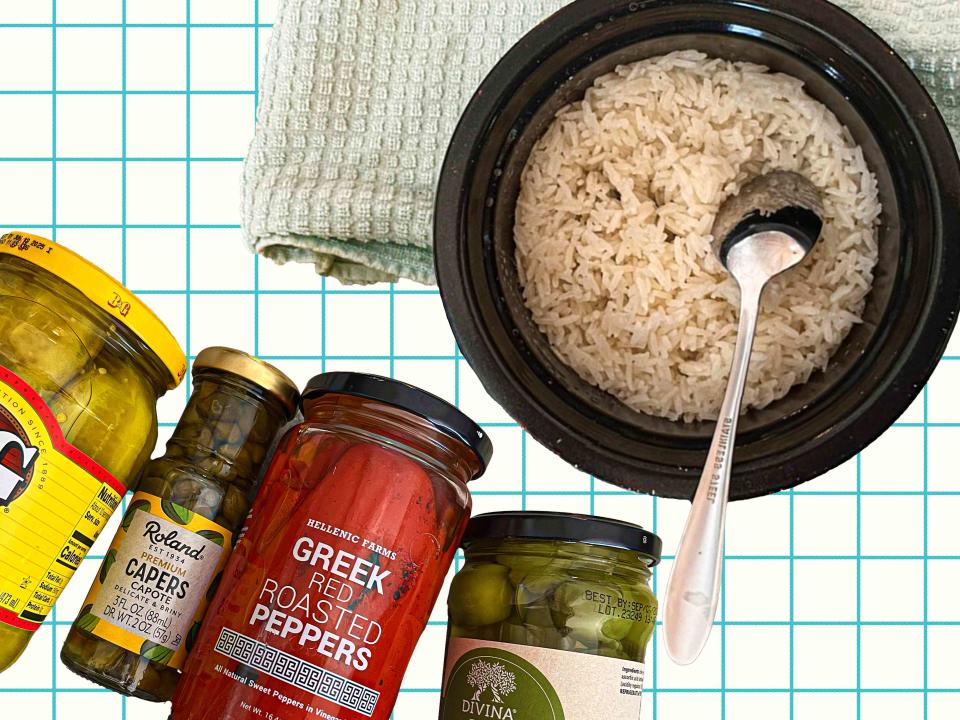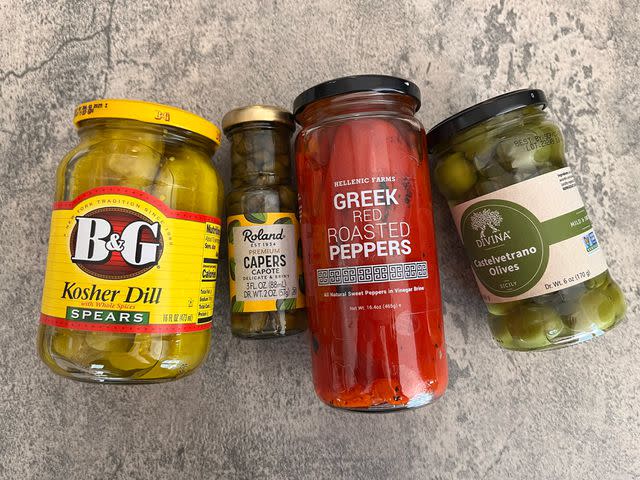So I've Been Cooking My Rice in Pickle Juice for a Week...
Testing four veggie brines yielded interesting, widely varying results.

Serious Eats / Kelli Solomon, Amanda Suarez
We've been stanning pickles for so long now, we're running out of ideas for what else to do with them. The other day, I found myself in the dustiest corner of the internet, looking for a new way to use my leftover jars of pickles and olives. There are endless uses for your leftover pickle juice, including salad dressing, sauces, martinis, marinades, and cheffy tricks, like making gelées. I hate tossing out perfectly good pickle juice, and rice seemed like the right blank canvas for absorbing all that briny flavor. So, where I ultimately landed was the incredibly simple trick of adding pickle juice and other brines to the cooking water for rice.
As questionable of an idea as it may seem, using pickles in and on rice isn't entirely new. Southeast Indian dishes like Achari Pulao include pickled vegetables or mango to add flavor to the rice while it’s cooking, and of course, pickled vegetables are a fabulous addition to rice bowls and kimbap, but the idea of using leftover pickle brine as a cooking liquid for rice was new to me. So I gave the method a try with the liquid from a jar of basic grocery store dill pickles, as well as with olive, caper, and sweet red pepper brine. Every condiment was suspended in a brine primarily composed of water, vinegar, and salt and there were no lacto-fermented pickles in my tests.
My Methodology
For each of the four tests, I cooked a small batch of basmati rice using my mini 2-cup rice cooker. For each test, I used 100g of rice, 50g of brine, and 100g of water for this test, but to try this at home, just make a standard pot of rice, replacing the water with a 2:1, water-to-brine ratio. Initially, I thought about replacing all the water with brine, but I did not want to risk making the rice overly salty.
Bring on the Brines

Serious Eats / Kelli Solomon
B&G Kosher Dill Pickle Spears
When I opened the jar of pickles, I was reminded of walking into a deli—these spears floating in yellow brine have the briny pickle smell and flavor I grew up with. Given the strong smell of the pickles, I expected the rice to taste more vinegary, but itonly had a faint taste of pickle and slightly salty-sour aftertaste that I started to notice after a few bites. This was not my favorite rice—the sour taste was one-note, and lacked complexity.
Divina Organic Castelvetrano Olives
There are far too many types of olives to choose from, so I just selected my favorite—Castelvetrano. The rice took on the mild, buttery flavor of the olives almost as if the slightest bit of olive oil or butter was added to the pot. I expected it to taste like a dirty martini, but it was far more subtle. This was the saltiest rice—not overly so, but noticeably. I enjoyed it, and would eat this rice with delicately cooked white fish or shrimp.
Roland Capote Capers
When I opened the jar, these capers had such a briny aroma I thought it would completely overpower the rice, but it didn’t. The caper-flavored rice tasted well-seasoned and not overly acidic or salty. As someone who doesn’t usually go for capers, I was pleasantly surprised by this rice. I would serve it with baked salmon, add it to stuffed vegetables, or serve it with another dish that needs a little punch of vinegar.
Hellenic Farms Greek Roasted Red Peppers
There were only a few options of peppers packed in a vinegar-based brine instead of oil. I wanted the brine to be comparable to the other preserved condiments, so I selected this jar of roasted red peppers. This rice was subtly sweet and had a mild pepper taste to match its slightly orange-tinged hue. After a few bites, I could pick up on the charred flavor from the roasting of the peppers, a welcome complexity. This rice is versatile enough to serve with all sorts of dishes, but it would pair particularly well with roasted chicken or grilled steak.
Yes, Try This at Home!
By the end of this test, I had so much pickle brine that I started to feel pickled myself. Oddly, in this head-to-head pickled rice test, the rice using dill pickle brine was actually the worst. Perhaps that was due to my choice of pickle. Maybe a garlicky brined pickle would lead to a pot of tasty garlic rice? I enjoyed the roasted pepper rice so much that I plan to add it to my side-dish rotation. I may even punch it up further with some bits of diced roasted pepper as well. As I looked at the half-eaten jars of pickled this or that in the back of my fridge, I eyed some banana peppers and artichokes. This experiment will absolutely be continued.
Read the original article on Serious Eats.

